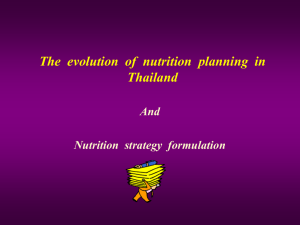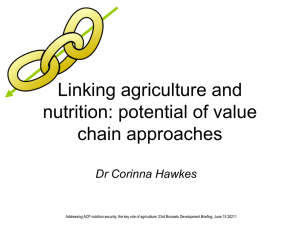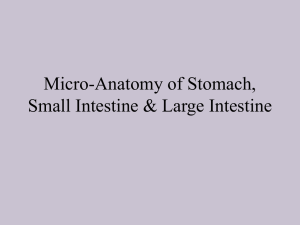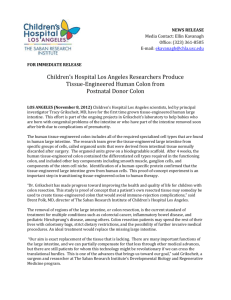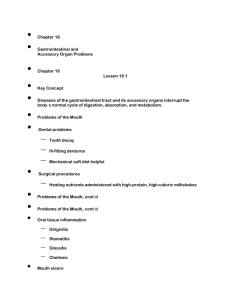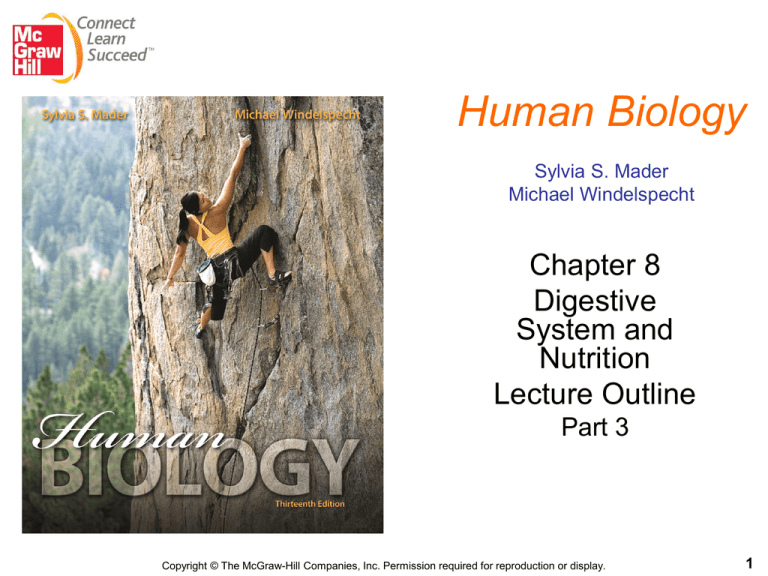
Human Biology
Sylvia S. Mader
Michael Windelspecht
Chapter 8
Digestive
System and
Nutrition
Lecture Outline
Part 3
Copyright © The McGraw-Hill Companies, Inc. Permission required for reproduction or display.
1
8.4 The Accessory Organs and Regulation of Secretions
How do hormones control
digestive gland secretions?
Copyright © The McGraw-Hill Companies, Inc. Permission required for reproduction or display.
gallbladder
liver
stomach
pancreas
duodenum
Figure 8.9 Hormonal control
and regulation of digestion.
secretin
CCK
gastrin
blood vessel
2
8.5 The Large Intestine and Defecation
The large intestine
• The large intestine includes the cecum, colon,
rectum, and anal canal.
• It is larger in diameter but shorter than the
small intestine.
• The cecum has a projection known as the
___________ that may play a role in fighting
infections.
3
8.5 The Large Intestine and Defecation
The large intestine
• Functions to
– absorb water to prevent ___________.
– absorb vitamins (B complex and K) produced
by intestinal flora.
– form and rid the body of feces through the
anus.
4
8.5 The Large Intestine and Defecation
The large intestine
Copyright © The McGraw-Hill Companies, Inc. Permission required for reproduction or display.
transverse colon
ascending
colon
small
intestine
descending
colon
cecum
orifice of
appendix
vermiform
appendix
rectum
internal anal sphincter
anal canal
sigmoid colon
external anal sphincter
anus
Figure 8.10 The regions of the large intestine.
5
8.5 The Large Intestine and Defecation
Disorders of the colon and rectum
• Diarrhea – increased ____________ and failure to
reabsorb water, due to either an infection or nervous
stimulation
• Constipation – feces are dry and hard; condition
may be controlled with water and fiber
• _____________ – enlarged and inflamed blood
vessels of the anus due to chronic constipation,
pregnancy, aging, or anal intercourse
• Diverticulosis – occurrence of pouches of mucosa
from weak spots in the _______________ that can
become infected; often occur in the descending
colon
6
8.5 The Large Intestine and Defecation
Disorders of the colon and rectum
• ______________________ (IBS) – muscularis layer
contracts with power, but without its normal
coordination; characterized by chronic diarrhea and
abdominal pain
• Inflammatory bowel disease/colitis (IBD) – a group
of inflammatory disorders such as ulcerative colitis
or Crohn’s disease
• Polyps and cancer – small growths found in the
epithelial lining that can be benign or cancerous
7
8.6 Nutrition and Weight Control
What is obesity? What is BMI?
• When an individual is grossly overweight and
has a ___________________ ≥ 30, he or she
is obese.
• BMI is a ____________ to estimate how much
of a person’s weight is due to adipose tissue.
• It _______ take into account gender, fitness, or
bone structure.
8
8.6 Nutrition and Weight Control
What is your BMI?
Copyright © The McGraw-Hill Companies, Inc. Permission required for reproduction or display.
Body Mass Index (BMI)
19
25
30
6’6”
underweight
healthy weight
overweight
obese
6’4”
6’2”
6’0”
Height
5’10”
5’8”
5’6”
5’4”
5’2”
5’0”
4’10”
50
75
100
125
150
175
200
225
250
275
Weight (lb)
Source: U.S. Department of Agriculture: Dietary Guidelines for Americans, 2005
Figure 8.11 The body mass index chart.
9
8.6 Nutrition and Weight Control
Why should we be concerned
with obesity?
• Obesity has doubled in the US in the last
20 years.
• In the US, ____ of adults are obese and it
is now prevalent in children and
adolescents.
• Obesity tends to increase with an increase
in income.
10
8.6 Nutrition and Weight Control
Why should we be concerned
with obesity?
• It is associated with an increased risk of
premature death, type 2 diabetes,
hypertension, CVD, stroke, gallbladder
disease, respiratory dysfunction,
osteoarthritis, and certain cancers.
11
8.6 Nutrition and Weight Control
Searching for the magic
weight-loss bullet
• Trendy diet programs
– Pritikin diet: high carbohydrate and fiber diet
through whole grains and vegetables
– Atkins: low-carbohydrate, and high protein and
fat diet
– Zone and South beach diets: low carbohydrate
diets that are high in protein and “healthy” fats
• Prescription drugs
12
8.6 Nutrition and Weight Control
Searching for the magic
weight-loss bullet
• Surgical procedures
– ____________: stapling or partitioning of a small
portion of the stomach
– ____________: attaching the lower part of the
small intestine to the stomach so most of the food
bypasses the stomach and small intestine
– ____________: a constriction band is used to
reduce stomach size
– ___________: removal of fat cells; best used for
overweight people that are not obese or morbidly
obese
13
8.6 Nutrition and Weight Control
To understand weight and nutrition, we first
have to understand nutrients
• Nutrients are components of food that are
needed to perform physiological body functions.
• Nutrients include
–
–
–
–
–
carbohydrates.
proteins.
lipids.
minerals.
vitamins.
14
8.6 Nutrition and Weight Control
Carbohydrates
• Carbohydrates are sugars or polysaccharides
that are digested into the simple sugars which
are an important energy source.
• _____________ should be minimized in the diet
because fiber and vitamins are removed (i.e.,
white bread, cake, and cookies).
• Complex carbohydrates are recommended as a
good source of vitamins and minerals (i.e.,
beans, whole-grain products, nuts, and fruits).
15
8.6 Nutrition and Weight Control
Can carbohydrates be harmful?
• Refined sugars and fructose sweeteners may
contribute to obesity.
• These foods may cause the ___________ to
secrete large amounts of insulin which can lead
to insulin resistance seen in type 2 diabetes
and increased fat metabolism.
• An increase in fat deposition may increase the
risk of coronary heart disease, liver diseases,
and certain cancers.
16
8.6 Nutrition and Weight Control
How can you reduce high-glycemic
index carbohydrates?
17
8.6 Nutrition and Weight Control
Proteins
• Proteins are digested into 20 different __________
which are used to produce cellular proteins.
• Essential amino acids are the __ amino acids that
must be attained through diet.
• __________________ that have all essential
amino acids are usually derived from animals such
as meat and dairy.
• Nonanimal sources of complete proteins are tofu,
soymilk, and other processed food from soybeans.
18
8.6 Nutrition and Weight Control
Proteins
• __________________ are ones that lack at least
one essential amino acid (i.e., legumes, nuts,
grains, etc.) and need to be combined with another
incomplete protein to allow all amino acids to be
used in the body.
• Amino acids cannot be stored in the body, thus
small amounts (2 meat servings) need to be
ingested on a ______ basis.
19
8.6 Nutrition and Weight Control
Can proteins be harmful?
• An overabundance of protein can result in
dehydration during exercise and sweating.
• An overabundance of proteins can lead to
calcium loss in urine which can lead to kidney
stones.
• Eating red meat as a source of protein is high
in saturated fats that can lead to ______
20






